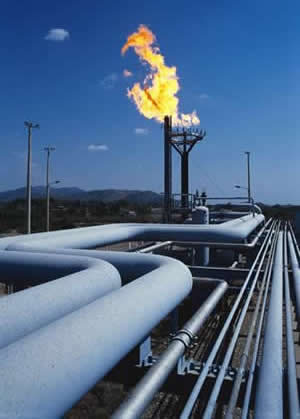Do We Need A Hydrocarbon Smart Grid?
The Oil And Gas Information Technology Innovation Dilemma
 The hydrocarbon logistics chain of natural gas and crude oil connects globally distributed exploration and production sites with industrial and private consumers via pipelines, tankers, rail cars, and trucks with massive intermediate buffering storage and conversion facilities (tank farms, refineries, gas plants); it is the lifeblood of our energy supply chain today and for the coming decades.
The hydrocarbon logistics chain of natural gas and crude oil connects globally distributed exploration and production sites with industrial and private consumers via pipelines, tankers, rail cars, and trucks with massive intermediate buffering storage and conversion facilities (tank farms, refineries, gas plants); it is the lifeblood of our energy supply chain today and for the coming decades.
More than 75 million barrels of oil and 300 billion cubic feet of natural gas are produced, transported, and consumed all over the globe — every day. Along the complex transportation chain, these special bulk products, both liquids and gases, are transferred between the different modes of transportation, resulting in a number of challenges based on complex measurements of product volumes and masses:
- Measurement accuracy. In an ideal world, we would always determine the mass of crude oil and natural gas at each measurement point; however, due to the large quantities involved, weighing is possible only at the very end of the logistics chain. Consequently, we have to live with measurement data that typically carries an uncertainty of 0.1% to 0.5 %, depending on the measurement devices’ intrinsic accuracy.
- Fluctuating volumes. Hydrocarbon volumes, which are the basis for pricing, excise duty, and transportation fees, fluctuate depending on environmental temperature and pressure conditions; as we require masses and weights for product valuation, and weighing is not possible, we must derive them from volumes at ambient temperature and pressure conditions, requiring complex conversion calculations of the observed volumes at each custody transfer point. Different units of measurement are in use globally, further complicating the issue, as even modern terminal automation systems do not support all units of measure.
- Manual errors. Calculations of price-relevant quantities at many transfer points still involve manual calculations using printed table values, pocket calculators, and spread sheets. Such procedures may introduce further errors (and sometimes theft) in addition to the unavoidable measurement uncertainties noted above.
- Misinterpretations. For a given batch of crude oil, one needs to calculate the mass and weight of the batch, where the mass and weight value typically differ by 0.1 %. Very often, because the same unit of measure (e.g., pound, long ton, metric ton, etc.) is used for mass and weight values, these quantities get mixed up, which may lead to further financial issues.
Considering the intrinsic complexity of the hydrocarbon logistics chain described, the following question arises: “Do we have a clear grip on the hydrocarbon volume flows?” I’m afraid we don’t, and it’s about time to think of innovation in the hydrocarbon value chain. We don’t have to search hard to find an example in a closely related industry: Under the pressure of changing market conditions, utility companies are implementing smart grid technologies to not only get more accurate and timely information on electricity distribution and consumption, but also to establish innovative and dynamic business models. The winners in this innovation battle will strive with new energy-related services based on bidirectional, real-time information technology, with the losers sitting on commoditizing assets.
While the IT-driven energy revolution in the utilities industry is eminent, the upstream part of the energy industry, the hydrocarbon value chain is still in slumber; although, its intrinsic challenges are much bigger (yes, the idea of the digital oil field has been around for many years, but after more than a decade, most oil and gas companies have maybe one or two pilot smart fields running).
Let’s face it – the oil and gas industry has an IT innovation problem!
Innovation in oil and gas means drilling deeper and faster; it’s all about material science and engineering. Despite (or maybe because of) the enormous profits, the oil and gas industry has so far put on the breaks when it comes to spending on information technology as a percentage of revenues. But it is apparent that the industry has a severe challenge that can, and must, be addressed by appropriate information technology that today can collect, process, analyze, and distribute huge amounts of data in (near) real-time like never before.
The complexity of the measurement — the calculation process along the hydrocarbon supply chain requires a high degree of automation, where the calculations are based on nationally and internationally agreed upon measurement standards. This data needs to be passed to central logistics systems, which provide the financial backbone for each company involved in the logistics chain.
Built-in checks preventing corrupt data flowing from the field to financial systems is a must, as well as transparency regarding the measurement standards that have been applied for product calculations. In this way, governance and compliance issues can be avoided in the area of product quantity data analysis.
New regulations will likely require that hydrocarbon volumes are also reported on an energy basis and include calculation of the content of greenhouse gases. Thus information technology solutions are required, which master the intrinsic complexity of the hydrocarbon product data quantity conversion, while at the same time providing guidance and nontechnical information to business users that require clear statements concerning compliance and reliability of the hydrocarbon data backbone. This affects all financial figures and ultimately determines the financial success of each energy industry company.
While the core hydrocarbon measurement problem is addressed, the new possibilities of smart information technology may lead to new, innovative, and more dynamic business models like today in utilities — and the energy revolution will eventually reach the oil and gas industry.
Please leave a comment or contact me directly.
Sincerely,
Holger